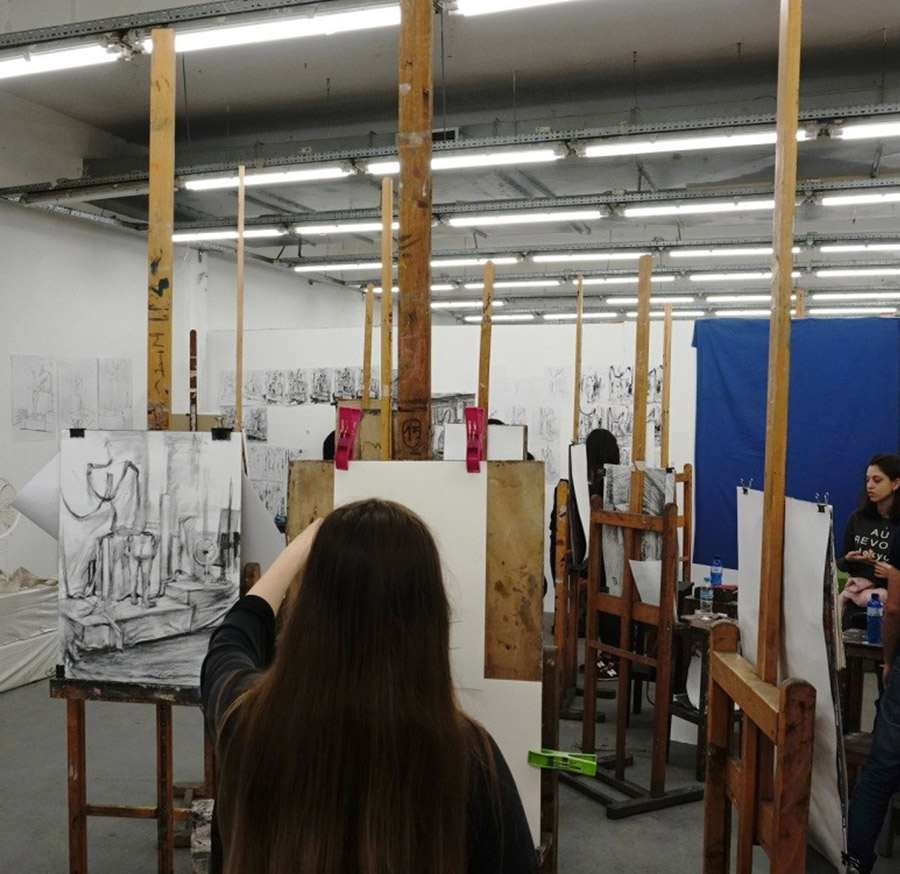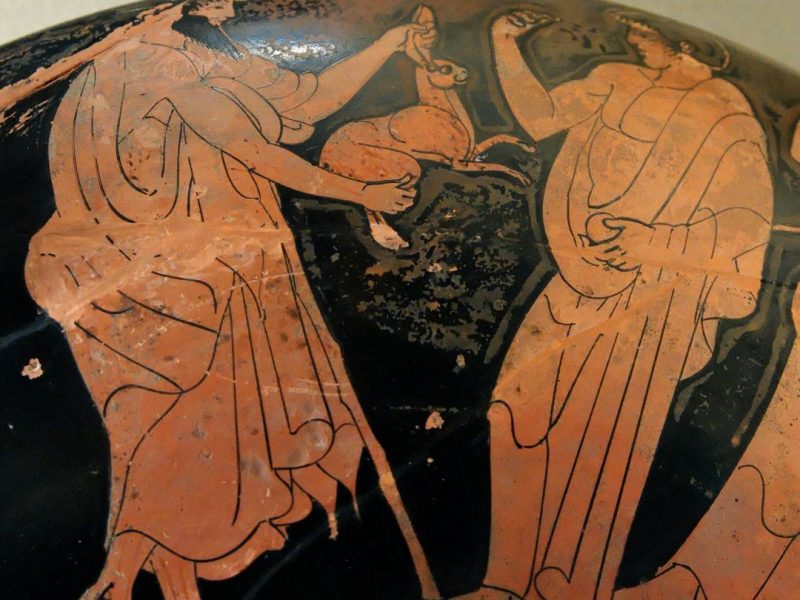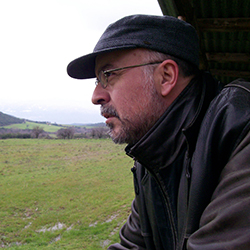3rd (Γ’) PAINTING STUDIO / DIRECTOR: M. SPILIOPOULOS

COURSE OUTLINE
DESCRIPTION
1st Semester
Introductory design exercises based on direct observation (still life and live model studies) as a means of familiarising students with the visual language.
Projects explore key elements such as point, line, shape, direction, tone, color, texture, material, and movement.
Lectures focus on color theory: warm/cool colors, contrasts, complements, tonal value, purity, and saturation.
A research-based assignment introduces students to the use of the library as a learning tool.
Color studies from life aim to develop an understanding of tonal variation, hue, and saturation, as well as the functional use of color in composition.
Students begin to develop technical and perceptual skills necessary for working on a two-dimensional surface, while becoming familiar with various materials and techniques.
Design exercises focus on form, line, and composition.
Visits to galleries and conversations with artists are integrated into the coursework.
2nd Semester
Advanced observational studies (still life and live model), aimed at developing skills in interpreting representational and perceptual space through painting.
Emphasis on image structure, techniques, and materials.
Parallel studies from life (model or composition) supported by themed assignments encourage experimentation with materials and methods, fostering a deeper understanding of visual language and expressive vocabulary.
Lectures are tailored to the corresponding exercises.
Students are required to submit a written paper on an artist of their choice, analysing the visual elements of three of their works.
Exercises begin incorporating alternative expressive tools such as photography and digital media.
Continued visits to exhibitions and museums complement studio practice.
3rd Semester
Plastic and design-based exercises aim to cultivate expressive experimentation and material literacy, while also advancing students’ compositional and associative abilities.
Students are encouraged to explore visual expression beyond strict representation.
Exposure to contemporary artistic practices enriches their expressive vocabulary and aesthetic awareness.
4th Semester
Focus on refining conceptual analysis and broadening visual and formal possibilities through studio practice.
Students enhance their compositional and expressive skills, deepening their understanding of the visual language through technical exploration.
5th Semester
Assignment: Self-Portrait, inspired by the work of Lucas Samaras and the photographic series Family by Philip Tsiaras.
The goal is to enhance students’ ability to explore and analyse conceptual frameworks, enriching their formal vocabulary and compositional abilities.
Familiarisation with Aesthetics and Art Theory supports the development of a personal visual idiom.
Students engage in extensive research, collecting references and analysing expressive strategies used by other artists in art history.
This process helps them understand how to craft a consciously constructed and meaningful artwork.
Exploration of form and content also fosters the development of verbal articulation to support their creative output.
Lecture: “Lucas Samaras – The Multifaceted Self: Bridging Two Worlds” and “Selfie – The Generation of Narcissism”
Lecturer: Marios Spiliopoulos
6th Semester
Continuation of the Self-Portrait project.
Upon completion, students should be able to interpret and analyse poetry and critical texts, exercising critical thinking and integrating deep insights into their visual expression.
An exhibition of student work is organised, showcasing a dialogue between visual art and literary/poetic texts.
Additional assignment: Students define a “private space” of spiritual or poetic significance as a basis for their creative exploration.
Continued visits to exhibitions and discussions with artists.
7th Semester
The central theme throughout the 4th year is “The Body” and its multiple interpretations across art history, sociology, and historical discourse.
Short exercises serve as preparatory works, exploring the body’s representation in different sociopolitical contexts and contemporary art.
Presentations span all fields of artistic expression (literature, poetry, music, film), focusing on various approaches to the body.
Guest lectures address theoretical aspects of the body and its relevance today, referencing texts by Emmanuel Levinas, Jacques Derrida, and Paul Ricoeur.
Students select a contemporary artist whose work involves the body and present a critical analysis in relation to their own artistic concerns.
Visits to exhibitions and artist talks further support this work.
8th Semester
Continuation of the “Body” project, with accompanying lectures:
-
“The Body as Representational Object: Vessel or Transmitter?” – Marios Spiliopoulos
-
“The Importance of Being Animal: Therianthropy in Visual Art” – Maria Yagiannou
-
“Fourth From the Truth: The Body in Cyberpunk” – Giorgos Lamprakos
-
“The Simulated Body: Nymphomaniac by Lars von Trier” – Dimitris Nakos
-
“From the Representation of Violence to the Violence of Representation: Reflections on E. Levinas” – Thomas Symeonidis
The semester concludes with the creation of complete visual proposals by students, leading to a curated group exhibition organised by the students themselves.
9th Semester
Definition of the expressive and theoretical framework for the student’s personal work, with comparative analysis of similar movements in art history.
Analysis and refinement of the visual strategies needed to develop their individual artistic language.
Students prepare for their final thesis project, integrating theoretical research with studio practice.
They must clarify their topic and plan the exhibition and theoretical support for their body of work.
Collaboration with students from the theoretical studies department is required for the thesis.
Workshop/Lecture by Dimitris Kozaris, visual artist and professor at the Accademia di Belle Arti, Carrara, Italy (Erasmus exchange program):
-
Lecture: “Rules of Screenwriting”
-
Workshop: “Design Methodology” using Vincenzo Cerami’s method (introductory level), covering narrative mechanisms such as memory, adventure, flashback, deus ex machina, and discovery. Short films were shown to illustrate these mechanisms.
-
Lecture: “Cinema and the City,” with screenings of short films and excerpts by Ivens, Wenders, Herzog, Reggio, and Fricke, followed by group discussion.
-
Student Presentations: Younger students presented their projects, discussing their creative approaches.
-
Workshop Conclusion: Group discussions on the short scripts developed by the students.
10th Semester
Completion of the final thesis project, combining theoretical research and studio practice.
The accompanying written work is developed in collaboration with a student from the theoretical studies department, encouraging interdisciplinary exchange.
A special unit for graduating students focuses on the Situationist International, highlighting the work of architect Constant and Guy Debord.
Primary texts include The Society of the Spectacle (1990) and Against Cinema (1977), supported by film screenings such as In girum imus nocte et consumimur igni.
The course prepares students to research, analyse, and synthesise complex issues in the international art scene using both traditional and contemporary media.
It also aims to equip them with the adaptability and critical thinking necessary to thrive in diverse cultural environments and contribute meaningfully to global contemporary art discourse.
Student Works



